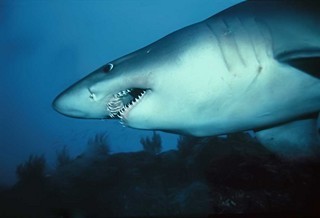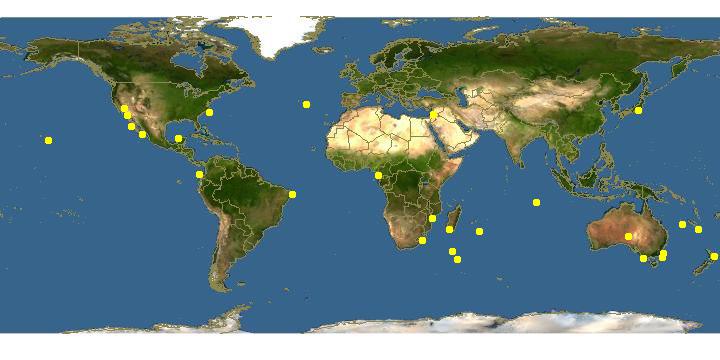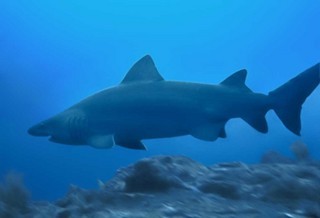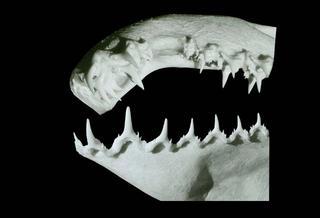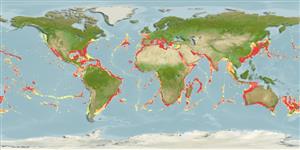|
| Links |
We parsed the following live from the Web into this page. Such content is managed by its original site and not cached on Discover Life. Please send feedback and corrections directly to the source. See original regarding copyrights and terms of use.
- Australian Faunal Directory
- FishBase
|
|
español |
|
|
Overview | |
Main identification features
A large shark with a robust body; head with a long, bulbously conical snout; eyes moderately large, without nictitating eyelids; mouth relatively long, extending behind eyes; 5 gill slits, all before pectoral; teeth moderately large with prominent dagger-like middle point and 2-3 small points on either side; second dorsal fin only slightly smaller than first dorsal and situated well in front of anal fin; tail fin asymmetrical with distinct notch at front top of base, and strong ventral lobe.
Medium grey on back, light grey below; young with black tips on dorsal fins.
Size: reaches 410 cm.
Habitat: rocky shores.
Depth: 10-530 m.
Circumglobal in mainly subtropical waters; in the eastern Pacific it is known from Southern California to the western Gulf of California; recently discovered at Malpelo, where it may have a resident population.
Attributes
Abundance: Common.
Cites: Not listed.
Climate Zone: North Temperate (Californian Province &/or Northern Gulf of California); Northern Subtropical (Cortez Province + Sinaloan Gap); Equatorial (Costa Rica to Ecuador + Galapagos, Clipperton, Cocos, Malpelo); Antitropical (North and South temperate).
Depth Range Max: 530 m.
Depth Range Min: 10 m.
Diet: bony fishes; mobile benthic crustacea (shrimps/crabs); octopus/squid/cuttlefish.
Eastern Pacific Range: Northern limit=33; Southern limit=4; Western limit=-118; Eastern limit=-82; Latitudinal range=29; Longitudinal range=36.
Egg Type: Live birth; No pelagic larva.
Feeding Group: Carnivore.
FishBase Habitat: Bathydemersal.
Global Endemism: Circumtropical ( Indian + Pacific + Atlantic Oceans); East Pacific + Atlantic (East +/or West); East Pacific + East (not West) Atlantic; All Pacific (West + Central + East); TEP non-endemic; "Transpacific" (East + Central &/or West Pacific); All species.
Habitat: Reef associated (reef + edges-water column & soft bottom); Rocks; Water column; Reef (rock &/or coral).
Inshore Offshore: Inshore; Inshore Only.
IUCN Red List: Data deficient; Listed.
Length Max: 410 cm.
Regional Endemism: Island (s); Continent; Continent + Island (s); Eastern Pacific non-endemic; Tropical Eastern Pacific (TEP) non-endemic; California province, primarily; Temperate Eastern Pacific, primarily; All species.
Residency: Resident.
Salinity: Marine; Marine Only.
Water Column Position: Bottom; Near Bottom; Bottom + water column;
|
|
|
Names | |
|
|
|
Links to other sites | |
|
|
|
References |
- Bellido-Millán, J.M. and Villavicencio-Garayzar, C.J., 2002., Pesqueria artesanal de tiburon en la region central del Golfo de California. En: Lozano-Vilano, M. L. (Ed.). Libro Jubilar en Honor al Dr. Salvador Contreras Balderas., Universidad Autonoma de Nuevo León:143-152.
- Compagno, L.J.V., 1999., Checklist of living elasmobranchs. In Hamlett W.C. (ed.) Sharks, skates, and rays: the biology of elasmobranch fishes., The John Hopkins University Press:471-498.
- Compagno, L.J.V., 1984., Sharks of the World. An annotated and illustrated catalogue of sharks species known to date. Part 1. Hexanchiformes to Lamniformes. FAO Species Catalogue., FAO Fish. Synop. No 125, 4(1):1-249.
- Eschmeyer , W. N. , Herald , E. S. and Hamman, H., 1983., A field guide to Pacific coast fishes of North America from the Gulf of Alaska to Baja California. Peterson Field Guide Ser. 28., Houghton Mifflin:336pp.
- Findley, L.T., Hendrickx, M.E., Brusca, R.C., van der Heiden, A.M., Hastings, P.A., Torre, J., 2003., Diversidad de la Macrofauna Marina del Golfo de California, Mexico., CD-ROM versión 1.0. Projecto de la Macrofauna del Golfo . Derechos reservados de los autores y Conservación Internacional.
- Fischer , W. , Krup , F. , Schneider , W. , Sommer , C. , Carpenter , K. E. and Niem, V. H., 1995., Guia FAO para la Identificacion de Especies de para los fines de la Pesca. Pacifico Centro-Oriental. Volumen II. Vertebrados - Parte 1., FAO2:647-1200.
- Galván-Magaña, F., Abitia-Cárdenas, L.A., Rodríguez-Romero, J., Pérez-España, H., Chávez-Ramos, H., 1996., Systematics list of the fishes from Cerralvo island, Baja California Sur, Mexico., Ciencias Marinas, 22:295-311.
- Galván-Magaña, F., Gutiérrez-Sánchez, F., Abitia-Cárdenas, L.A., Rodríguez-Romero, J., 2000., The distribution and affinities of the shore fishes of the Baja California Sur lagoons. In Aquatic Ecosystems of Mexico: Status and Scope. Eds. M. Manuwar, S.G. Lawrence, I.F. Manuwar & D.F. Malley. Ecovision World Monograph Series., Backhuys Publishers:383-398.
- Love, M.S., Mecklenburg, C.W., Mecklenburg, T.A., Thorsteinson, L.K., 2005., es of the West Coast and Alaska: a checklist of North Pacific and Artic Ocena species from Baja California to the Alaska-Yukon border., U.S. Department of the Interior, U.S. Geological Survey, Biological Resources Division, 288pp.
- Risso, A., 1810., Ichthyologie de Nice, ou histoire naturelle des poissons du département des Alpes Maritimes. F. Schoell, Paris., Ichthyol. Nice, :1-388.
- Van der Heiden , A. M. and Findley, L. T., 1988., Lista de los peces marinos del sur de Sinaloa, México., Anales del Centro de Ciencias del Mar y Limnologia de la Universidad Autonoma Nacional de Mexico, 15:209-224.
|
|
|
Acknowledgements | |
I thank Ashley MacDonald and John Pickering, University of Georgia, for technical support in building this page.
|
|
| Supported by | |
|
Following modified from Australian Faunal Directory
|
Top | See original
| &pull 20q v5.145 20180528: Error 301 Moved Permanently http://biodiversity.org.au/afd/taxa/05caf060-30d9-4cdd-a4d5-0576f46d5696 |
|
Following modified from FishBase
|
Top | See original
http://www.fishbase.org/Summary/speciesSummary.php?genusname=Odontaspis&speciesname=ferox ---> http://192.134.151.83/Summary/speciesSummary.php?genusname=Odontaspis&speciesname=ferox
http://192.134.151.83/Summary/speciesSummary.php?genusname=Odontaspis&speciesname=ferox ---> https://fishbase.mnhn.fr/Summary/speciesSummary.php?genusname=Odontaspis&speciesname=ferox
https://fishbase.mnhn.fr/Summary/speciesSummary.php?genusname=Odontaspis&speciesname=ferox ---> https://fishbase.mnhn.fr/summary/Odontaspis-ferox.html
Odontaspis ferox, Smalltooth sand tiger : fisheries

You can
sponsor
this page
Common name (e.g. trout)
Genus + Species (e.g. Gadus morhua)
-

-
About this page
-
Languages
-
User feedbacks
-
Citation
-
Uploads
-
Related species
-


 Smalltooth sand tiger
Add your observation in
Fish Watcher
Upload your
photos
and
videos
Smalltooth sand tiger
Add your observation in
Fish Watcher
Upload your
photos
and
videos
Pictures
|
Google image
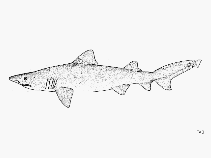 Odontaspis ferox
Odontaspis ferox
Picture by
FAO
Elasmobranchii (sharks and rays) >
Lamniformes
(Mackerel sharks) >
Odontaspididae
(Sand tiger sharks)
Etymology:
Odontaspis:
Etymology not explained, presumably
odontos
(Gr.), tooth, and
aspis
(Gr.), shield, perhaps referring to how teeth comprise a prominent narrow cusp provided with two or more small âside teethâ (translation), i.e., cusplets, which, with some imagination, could be said to âshieldâ the main cusp; another explanation:
aspis
(L.), viper, perhaps referring to outwardly pointing teeth of
O. ferox
, like that of a viper. (
See ETYFish
)
;
ferox:
Latin for fierce, possibly referring to what Risso described as its âLa voracité extrêmeâ and/or its toothy and ferocious countenance. (
See ETYFish
)
.
More on author:
Risso
.
Environment: milieu / climate zone / depth range / distribution range
Ecology
Marine; benthopelagic; depth range 10 - 2000 m (Ref.
26346
), usually 13 - 880 m (Ref.
89422
). Deep-water; 50°N - 49°S, 180°W - 180°E (Ref.
54681
)
Eastern Atlantic: Gulf of Gascony, Madeira, Morocco, Mediterranean; also Cape Verde (Ref.
27000
). Western Atlantic: Yucatan Shelf, Mexico (Ref.
9939
), Brazil (Ref.
53443
). Indo-West Pacific: off South Africa and Maldives, Madagascar, southern Japan, Australia, and New Zealand (Ref.
13568
). Expected to occur in the Western Central Pacific (Ref.
13568
). Central Pacific: off Hawaii (Ref.
13568
). Eastern Pacific: off southern California, USA and Baja California, Mexico (Ref.
13568
).
Length at first maturity / Size / Weight / Age
Maturity: L
m
?
range ? - 360 cm
Max length : 450 cm TL male/unsexed; (Ref.
89422
); max. published weight: 289.0 kg (Ref.
9939
)
Dorsal
spines
(total): 0;
Dorsal
soft rays
(total): 0;
Anal
spines
: 0;
Anal
soft rays
: 0. A shark with a short, pointed snout, small eyes, protruding spike-like teeth, and small, equal-sized dorsal and anal fins; first dorsal closer to pectoral than to pelvic fins (Ref.
5578
). Grey above, paler below (Ref.
6586
); may have red spots on sides (Ref.
5578
).
Found on or near the bottom of the continental and insular shelves and upper slopes (Ref.
6871
); sometimes in shallow water (Ref.
6871
). Tagging showed the species dives up to 2,000 m at Malpelo Island, Colombia (S.Bessudo, pers.comm. 06/09). Feeds on small bony fishes, squids, and crustaceans (Ref.
13568
). Uses its long body cavity and large, oily liver to regulate buoyancy. Ovoviviparous, embryos feeding on yolk sac and other ova produced by the mother (Ref.
50449
). Not implicated in attacks on people (Ref.
247
). Flesh utilized for human consumption and liver for its high squalene content (Ref.
247
); utilization of fins, jaws and cartilage (Ref.58048).
Life cycle and mating behavior
Maturity
|
Reproduction
|
Spawning
|
Eggs
|
Fecundity
|
Larvae
Exhibit ovoviparity (aplacental viviparity), with embryos feeding on other ova produced by the mother (oophagy) after the yolk sac is absorbed (Ref.
50449
). Two young born at 105 cm or larger (Ref.
26346
). Distinct pairing with embrace (Ref.
205
).
Compagno, L.J.V.
, 1984. FAO Species Catalogue. Vol. 4. Sharks of the world. An annotated and illustrated catalogue of shark species known to date. Part 1 - Hexanchiformes to Lamniformes. FAO Fish. Synop. 125(4/1):1-249. Rome, FAO. (Ref.
247
)
IUCN Red List Status (Ref.
130435
)
Vulnerable (VU)
(A2bd); Date assessed:
14 February 2015
CITES
Not Evaluated
Not Evaluated
Threat to humans
Harmless (Ref.
247
)
Human uses
Fisheries: commercial
FAO - Fisheries:
species profile
; Publication:
search
|
FishSource
|
More information
Countries
FAO areas
Ecosystems
Occurrences
Introductions
Stocks
Ecology
Diet
Food items
Food consumption
Ration
Common names
Synonyms
Metabolism
Predators
Ecotoxicology
Reproduction
Maturity
Spawning
Spawning aggregation
Fecundity
Eggs
Egg development
Age/Size
Growth
Length-weight
Length-length
Length-frequencies
Morphometrics
Morphology
Larvae
Larval dynamics
Recruitment
Abundance
BRUVS
References
Aquaculture
Aquaculture profile
Strains
Genetics
Electrophoreses
Heritability
Diseases
Processing
Nutrients
Mass conversion
Collaborators
Pictures
Stamps, Coins Misc.
Sounds
Ciguatera
Speed
Swim. type
Gill area
Otoliths
Brains
Vision
Tools
E-book
|
Field guide
|
Identification keys
|
Length-frequency wizard
|
Life-history tool
|
Point map
|
Classification Tree
|
Catch-MSY
|
Special reports
Check for Aquarium maintenance
|
Check for Species Fact Sheets
|
Check for Aquaculture Fact Sheets
Download XML
Summary page
|
Point data
|
Common names
|
Photos
Internet sources
AFORO (otoliths) |
Aquatic Commons
|
BHL
|
Cloffa
|
BOLDSystems
|
Websites from users
|
Check FishWatcher
|
CISTI
|
Catalog of Fishes
:
genus
,
species
|
DiscoverLife
|
ECOTOX
| FAO - Fisheries:
species profile
; Publication:
search
|
Faunafri
| Fishipedia |
Fishtrace
| GenBank:
genome
,
nucleotide
|
GloBI
|
Google Books
|
Google Scholar
|
Google
| IGFA World Record |
MitoFish
|
National databases
|
Otolith Atlas of Taiwan Fishes
|
PubMed
| Reef Life Survey | Socotra Atlas |
Tree of Life
| Wikipedia:
Go
,
Search
| World Records Freshwater Fishing |
Zoological Record
Estimates based on models
Preferred temperature (Ref.
123201
): 12.2 - 23.9, mean 17.3 °C (based on 810 cells).
Phylogenetic diversity index (Ref.
82804
): PD
50
= 0.8125 [Uniqueness, from 0.5 = low to 2.0 = high].
Bayesian length-weight: a=0.01122 (0.00514 - 0.02450), b=3.04 (2.87 - 3.21), in cm total length, based on all LWR estimates for this body shape (Ref.
93245
).
Trophic level (Ref.
69278
): 4.2 ±0.56 se; based on food items.
Resilience (Ref.
120179
): Very Low, minimum population doubling time more than 14 years (Fec assumed to be <10).
Fishing Vulnerability (Ref.
59153
): Very high vulnerability (90 of 100).
Price category (Ref.
80766
):
Unknown
.
Nutrients (Ref.
124155
): Calcium = 2.12 [0.49, 12.27] mg/100g; Iron = 0.217 [0.051, 0.701] mg/100g; Protein = 18.4 [16.0, 20.8] %; Omega3 = 0.34 [0.14, 0.81] g/100g; Selenium = 26.9 [7.0, 81.4] μg/100g; VitaminA = 6.46 [1.47, 28.36] μg/100g; Zinc = 0.187 [0.092, 0.357] mg/100g (wet weight);
Back to Search
Random Species
Back to Top
Accessed through:
Not available
FishBase mirror site :
localhost
Page last modified by :
mrius-barile
- 20 July 2016
Fatal error
: Uncaught ArgumentCountError: Too few arguments to function checkEcotox(), 1 passed in /var/www/html/summary/speciessummary.php on line 2304 and exactly 3 expected in /var/www/html/includes/speciessummary.lib.php:2579 Stack trace: #0 /var/www/html/summary/speciessummary.php(2304): checkEcotox() #1 {main} thrown in
/var/www/html/includes/speciessummary.lib.php
on line
2579
|
Updated: 2024-04-20 00:44:51 gmt
|
